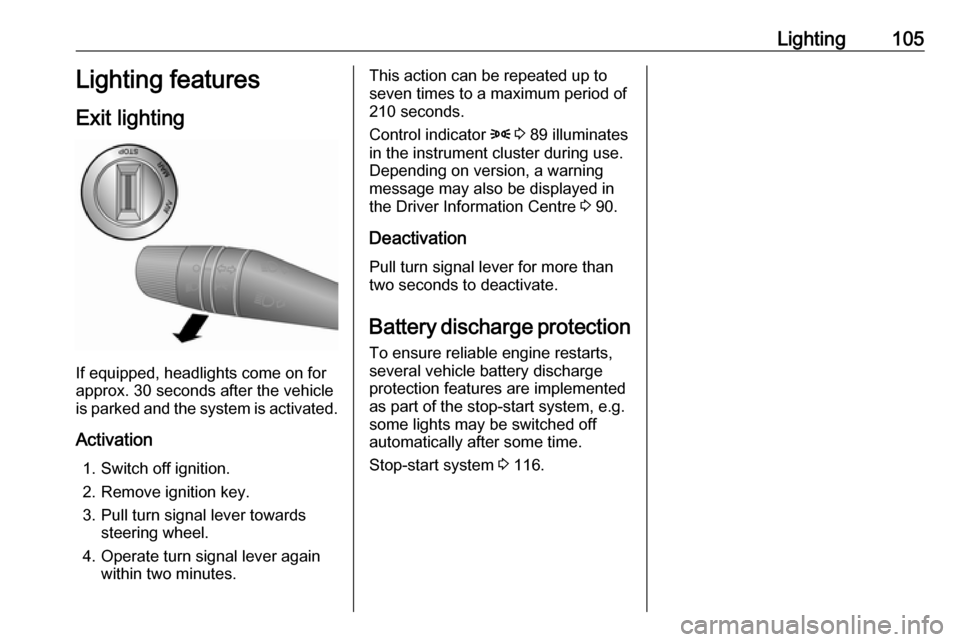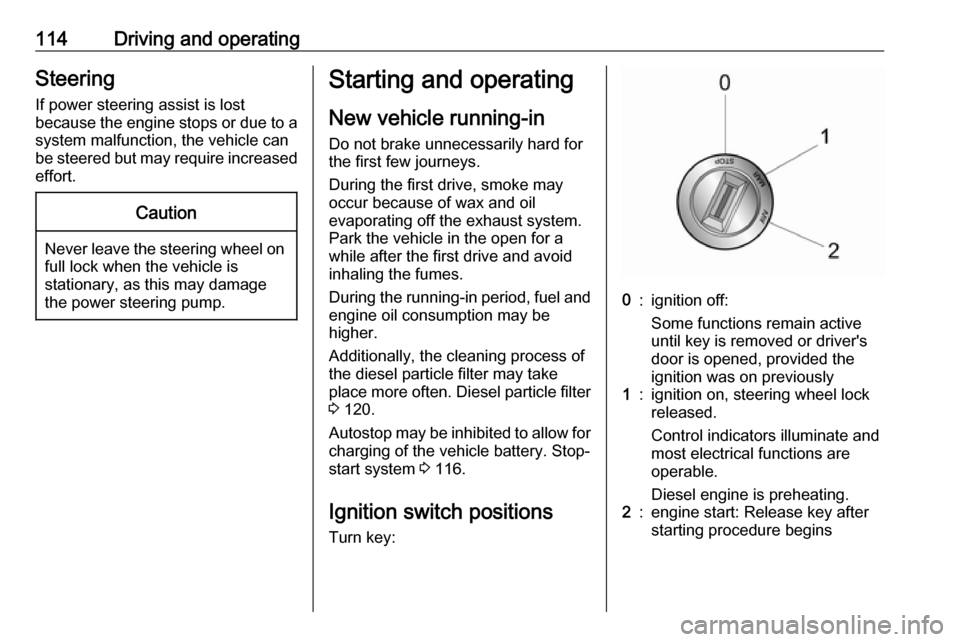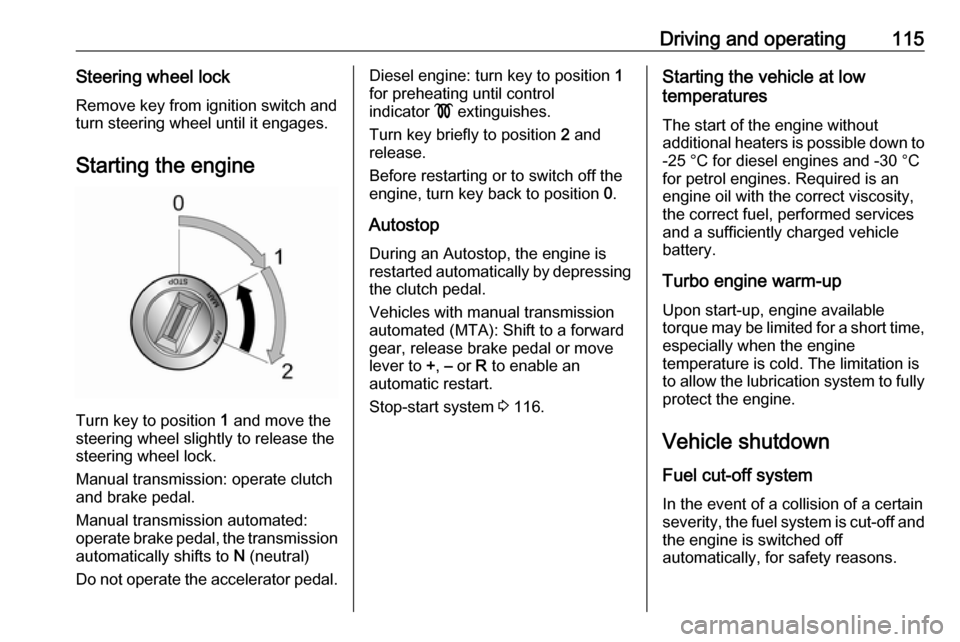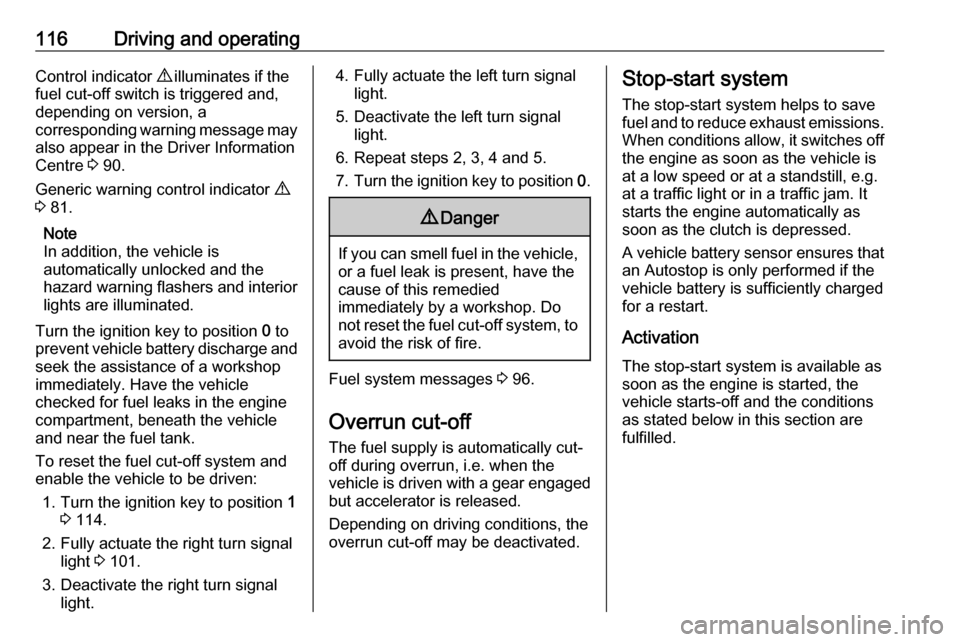ignition OPEL COMBO D 2017.5 Manual user
[x] Cancel search | Manufacturer: OPEL, Model Year: 2017.5, Model line: COMBO D, Model: OPEL COMBO D 2017.5Pages: 201, PDF Size: 4.76 MB
Page 107 of 201

Lighting105Lighting features
Exit lighting
If equipped, headlights come on for
approx. 30 seconds after the vehicle
is parked and the system is activated.
Activation 1. Switch off ignition.
2. Remove ignition key.
3. Pull turn signal lever towards steering wheel.
4. Operate turn signal lever again within two minutes.
This action can be repeated up to
seven times to a maximum period of
210 seconds.
Control indicator 8 3 89 illuminates
in the instrument cluster during use.
Depending on version, a warning
message may also be displayed in
the Driver Information Centre 3 90.
Deactivation Pull turn signal lever for more thantwo seconds to deactivate.
Battery discharge protection
To ensure reliable engine restarts,
several vehicle battery discharge
protection features are implemented
as part of the stop-start system, e.g.
some lights may be switched off
automatically after some time.
Stop-start system 3 116.
Page 115 of 201

Driving and operating113Driving and
operatingDriving hints ............................... 113
Control of the vehicle ...............113
Steering ................................... 114
Starting and operating ...............114
New vehicle running-in ............114
Ignition switch positions ...........114
Starting the engine ..................115
Vehicle shutdown ....................115
Overrun cut-off ........................ 116
Stop-start system ....................116
Parking .................................... 119
Engine exhaust .......................... 120
Diesel particle filter ..................120
Catalytic converter ...................120
Manual transmission ..................121
Manual transmission automa‐ ted .............................................. 122
Transmission display ...............122
Starting the engine ..................122
Selector lever .......................... 122
Manual mode ........................... 124
Electronic driving programmes 124
Fault ........................................ 125Brakes........................................ 126
Antilock brake system .............126
Parking brake .......................... 127
Brake assist ............................. 127
Hill start assist ......................... 127
Ride control systems .................128
Traction Control system ..........128
Electronic Stability Control ......129
Driver assistance systems .........130
Cruise control .......................... 130
Parking assist .......................... 131
Fuel ............................................ 134
Fuel for petrol engines .............134
Fuel for diesel engines ............134
Fuel for natural gas operation . 134
Refuelling ................................ 135
Fuel consumption - CO 2-
Emissions ............................... 137
Trailer hitch ................................ 138
General information .................138
Driving characteristics and towing tips .............................. 138
Trailer towing ........................... 138Driving hints
Control of the vehicle
Never coast with engine not
running (except during Autostop)
Many systems will not function in this
situation (e.g. brake servo unit, power
steering). Driving in this manner is a
danger to yourself and others. All
systems function during an Autostop,
but there may be a controlled
reduction in power steering assist and
vehicle speed is reduced.
Stop-start system 3 116.
Pedals
To ensure the pedal travel is
uninhibited, there must be no mats in the area of the pedals.
Use only floor mats which fit properly
and are fixed by the retainers on the
driver's side.
Driving downhill
Engage a gear when driving downhill to ensure that sufficient brake
pressure is available.
Page 116 of 201

114Driving and operatingSteeringIf power steering assist is lost
because the engine stops or due to a
system malfunction, the vehicle can
be steered but may require increased
effort.Caution
Never leave the steering wheel on
full lock when the vehicle is
stationary, as this may damage
the power steering pump.
Starting and operating
New vehicle running-in Do not brake unnecessarily hard for
the first few journeys.
During the first drive, smoke may
occur because of wax and oil
evaporating off the exhaust system.
Park the vehicle in the open for a
while after the first drive and avoid
inhaling the fumes.
During the running-in period, fuel and engine oil consumption may be
higher.
Additionally, the cleaning process of
the diesel particle filter may take
place more often. Diesel particle filter
3 120.
Autostop may be inhibited to allow for charging of the vehicle battery. Stop-start system 3 116.
Ignition switch positions Turn key:0:ignition off:
Some functions remain active
until key is removed or driver's
door is opened, provided the
ignition was on previously1:ignition on, steering wheel lock
released.
Control indicators illuminate and
most electrical functions are
operable.
Diesel engine is preheating.2:engine start: Release key after
starting procedure begins
Page 117 of 201

Driving and operating115Steering wheel lockRemove key from ignition switch and
turn steering wheel until it engages.
Starting the engine
Turn key to position 1 and move the
steering wheel slightly to release the
steering wheel lock.
Manual transmission: operate clutch
and brake pedal.
Manual transmission automated:
operate brake pedal, the transmission
automatically shifts to N (neutral)
Do not operate the accelerator pedal.
Diesel engine: turn key to position 1
for preheating until control
indicator ! extinguishes.
Turn key briefly to position 2 and
release.
Before restarting or to switch off the
engine, turn key back to position 0.
Autostop During an Autostop, the engine is
restarted automatically by depressing
the clutch pedal.
Vehicles with manual transmission
automated (MTA): Shift to a forward
gear, release brake pedal or move
lever to +, – or R to enable an
automatic restart.
Stop-start system 3 116.Starting the vehicle at low
temperatures
The start of the engine without
additional heaters is possible down to -25 °С for diesel engines and -30 °C
for petrol engines. Required is an engine oil with the correct viscosity,
the correct fuel, performed services
and a sufficiently charged vehicle
battery.
Turbo engine warm-up Upon start-up, engine available
torque may be limited for a short time, especially when the engine
temperature is cold. The limitation is
to allow the lubrication system to fully
protect the engine.
Vehicle shutdown
Fuel cut-off system In the event of a collision of a certain
severity, the fuel system is cut-off and
the engine is switched off
automatically, for safety reasons.
Page 118 of 201

116Driving and operatingControl indicator 9 illuminates if the
fuel cut-off switch is triggered and, depending on version, a
corresponding warning message may also appear in the Driver InformationCentre 3 90.
Generic warning control indicator 9
3 81.
Note
In addition, the vehicle is
automatically unlocked and the
hazard warning flashers and interior
lights are illuminated.
Turn the ignition key to position 0 to
prevent vehicle battery discharge and
seek the assistance of a workshop
immediately. Have the vehicle
checked for fuel leaks in the engine
compartment, beneath the vehicle
and near the fuel tank.
To reset the fuel cut-off system and
enable the vehicle to be driven:
1. Turn the ignition key to position 1
3 114.
2. Fully actuate the right turn signal light 3 101.
3. Deactivate the right turn signal light.4. Fully actuate the left turn signal light.
5. Deactivate the left turn signal light.
6. Repeat steps 2, 3, 4 and 5.
7. Turn the ignition key to position 0.9 Danger
If you can smell fuel in the vehicle,
or a fuel leak is present, have the
cause of this remedied
immediately by a workshop. Do
not reset the fuel cut-off system, to avoid the risk of fire.
Fuel system messages 3 96.
Overrun cut-off The fuel supply is automatically cut-
off during overrun, i.e. when the
vehicle is driven with a gear engaged
but accelerator is released.
Depending on driving conditions, the
overrun cut-off may be deactivated.
Stop-start system
The stop-start system helps to save
fuel and to reduce exhaust emissions. When conditions allow, it switches off
the engine as soon as the vehicle is
at a low speed or at a standstill, e.g.
at a traffic light or in a traffic jam. It
starts the engine automatically as
soon as the clutch is depressed.
A vehicle battery sensor ensures that an Autostop is only performed if thevehicle battery is sufficiently charged
for a restart.
Activation
The stop-start system is available as
soon as the engine is started, the
vehicle starts-off and the conditions
as stated below in this section are
fulfilled.
Page 119 of 201

Driving and operating117Deactivation
Deactivate the stop-start system
manually by pressing ^ in the centre
console. LED in the button illuminates
to confirm deactivation.
Depending on version, a
corresponding message, e.g.
Start&Stop disconnected , may also
be displayed in the Driver Information
Centre 3 90.
Autostop
If the vehicle is at a low speed or at a standstill, activate an Autostop as
follows:
● depress the clutch pedal
● set the lever to neutral
● release the clutch pedal
The engine will be switched off while the ignition stays on.
An Autostop is indicated when control
indicator ^ flashes in the Driver
Information Centre 3 90.
During an Autostop, the heating,
power steering and brake
performance will be maintained.
Caution
The power steering assist may be
reduced during an Autostop.
Conditions for an Autostop
The stop-start system checks if each
of the following conditions is fulfilled.
Otherwise an Autostop will be
inhibited.
● the stop-start system is not manually deactivated
● the bonnet is fully closed
● the driver's door is closed and the
driver's seat belt is fastened
● the vehicle battery is sufficiently charged and in good condition
● the engine is warmed up
● the engine coolant temperature is
not too high
● the engine exhaust temperature is not too high, e.g. after driving
with high engine load
● the ambient temperature is not too low
● the climate control system allows
an Autostop
Page 121 of 201

Driving and operating119Parking9Warning
● Do not park the vehicle on an
easily ignitable surface. The
high temperature of the
exhaust system could ignite the
surface.
● Always apply parking brake without pressing release
button. Apply as firmly as
possible on a downhill slope or
uphill slope. Depress brake
pedal at the same time to
reduce operating force.
● Switch off the engine.
● If the vehicle is on a level surface or uphill slope, engage
first gear before switching off
the ignition. On an uphill slope,
turn the front wheels away from
the kerb.
If the vehicle is on a downhill
slope, engage reverse gear
before switching off the ignition. Turn the front wheels towardsthe kerb.
● Close the windows.
● Turn the ignition key to position
0 and remove it from the
ignition switch. Turn the
steering wheel until the
steering wheel lock is felt to
engage.
● Lock the vehicle 3 24.
● Activate the anti-theft locking system 3 29.
● The engine cooling fans may run
after the engine has been
switched off 3 142.
Caution
After running at high engine
speeds or with high engine loads,
operate the engine briefly at a low load or run in neutral for
approx. 30 seconds before
switching off, in order to protect
the turbocharger.
Note
In the event of an accident with
airbag deployment, the engine is
switched off automatically if the
vehicle comes to a standstill within a
certain time.
Page 126 of 201

124Driving and operatingSwitch off engine if stopping for a
lengthy period, e.g. in traffic jams.
Engine braking
Automatic mode
When driving downhill, the manual
transmission automated does not
shift into higher gears until a fairly
high engine speed has been reached. It shifts down in good time when
braking.
Manual mode
To utilise the engine braking effect, select a lower gear in good time when
driving downhill.
Rocking the vehicle Rocking the vehicle is only
permissible if the vehicle is stuck in
sand, mud, snow or a hole. Move the
selector lever between R and A/M (or
between + and -) in a repeat pattern,
while applying light pressure to the
accelerator pedal. Do not race the
engine and avoid sudden
acceleration.Parking
Apply the parking brake. The most recently engaged gear (see
transmission display) remains
engaged.Caution
Do not leave the vehicle with the
transmission in position N.
When the ignition is switched on, a
warning chime will sound when the
vehicle is parked if the transmission is still in N.
When the ignition is switched off, the transmission no longer responds to
movement of the selector lever.
Manual mode If engine speed is too low, the
transmission automatically shifts to a
lower gear.
In manual mode, no automatic
shifting to a higher gear takes place
at high engine revolutions. If engine
speed is too high, the transmission
only switches to a higher gear via
kickdown 3 124.
When gearshifting is recommended
to improve fuel economy, control
indicator [ or Ò illuminates in the
Driver Information Centre 3 85.
Electronic driving programmes
Eco mode E
When automatic mode is engaged,
the Eco mode can be selected to
reduce fuel consumption.
Page 131 of 201

Driving and operating129Deactivation
ASR can be switched off when
spinning of drive wheels is required:
press ASR OFF briefly.
LED in button illuminates and,
depending on version, a
corresponding message, e.g. ASR
disconnect , may also be displayed in
the Driver Information Centre 3 90.
ASR is reactivated by pressing
ASR OFF again.
ASR is also reactivated the next time
the ignition is switched on.
Fault
ASR will switch off automatically in the event of a fault. Control indicator
R will illuminate in the instrument
cluster. Depending on version, a
corresponding message, e.g. ESP
unavailable , may also appear in the
Driver Information Centre 3 90.
Have the cause of the fault remedied by a workshop.
Control indicator R 3 85.
Electronic Stability Control
Electronic Stability Control (ESC)
improves driving stability when
necessary, regardless of the type of
road surface or tyre grip. It also
prevents the drive wheels from
spinning.
As soon as the vehicle starts to
swerve (understeer/oversteer),
engine output is reduced and the wheels are braked individually. This
considerably improves the driving
stability of the vehicle on slippery road
surfaces.
ESC is operational after each engine
start as soon as control indicator R
extinguishes.
When ESC operates, R flashes.
The ESC system is automatically
activated when the vehicle is started
and cannot be deactivated.
9 Warning
Do not let this special safety
feature tempt you into taking risks
when driving.
Adapt speed to the road
conditions.
Page 133 of 201

Driving and operating131Turn end of lever to the ON position;
control indicator m 3 90 illuminates in
the instrument cluster. Depending on
version, a corresponding message,
e.g. Cruise Control on , may also be
displayed in the Driver Information
Centre 3 90.
Activation Accelerate to the desired speed and
push lever upwards ( +); the current
speed is stored and maintained.
Accelerator pedal can be released.
Vehicle speed can be increased by
depressing the accelerator pedal.
When the accelerator pedal is
released, the previously stored speed
is resumed.
Cruise control remains activated
while gearshifting.
Increase speed
With cruise control active, push lever
upwards ( +) or briefly push lever
upwards ( +) repeatedly: speed
increases continuously or in small
increments.Alternatively accelerate to the desired speed and store by pushing lever
upwards ( +).
Reduce speed
With cruise control active, push lever
downwards ( -) or briefly push lever
downwards ( -) repeatedly; speed
decreases continuously or in small
increments.
Deactivation Automatic deactivation: ● vehicle speed below approx. 30 km/h
● the brake pedal is depressed
● the clutch pedal is depressed
● the traction control system/Anti- Slip Regulator (ASR) or
Electronic Stability Control (ESC)
is operating
● the antilock brake system (ABS) is operating
Resume stored speed
Press = at a speed above 30 km/h.
The stored speed will be obtained.Switching off
Turn end of lever to the OFF position;
control indicator m extinguishes. The
stored speed is deleted. Switching off the ignition also deletes the stored
speed.
Parking assist9 Warning
It is the driver who bears full
responsibility for the parking
manoeuvre.
Always check the surrounding
area while reversing and using the parking assist system.
The parking assist makes parking
easier by measuring the distance between the vehicle and obstacles,
and giving acoustic signals.